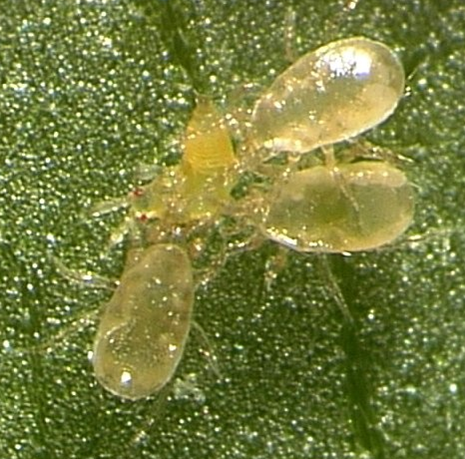Cucumeris Neoseiulus cucumeris
Neoseiulus (= Amblyseius) cucumeris (Cucumeris) is a predatory mite that is particularly effective against thrips such as western flower thrips (Frankliniella occidentalis) and onion thrips (Thrips tabaci).
Description and biology
Cucumeris mites are less than 1mm in length. They can be distinguished from most pest mites by their shape and mobility. Cucumeris is teardrop shaped and moves rapidly along the underside of leaves and in flowers. Development of the mite takes from 8-11 days at (25-20°C). Cucumeris mites can live up to 32 days and females produce an average of 35 eggs in their lifetime. Cucumeris prefer environments with greater than 65% relative humidity (RH), but eggs can survive as low as 40% RH. Microclimates within the greenhouse crop appear to be important for their survival. Cucumeris feed on small (1st and 2nd instar) thrips on foliage and flowers, and will not feed on large larvae or adult thrips. The primary target of Cucumeris is thrips species including western flower thrips, onion thrips, and plague thrips. Cucumeris is a generalist predator, and will also feed on other mites and pollen and has been valuable in the control of broad mite.
Suitable crops
Cucumeris is suitable for most greenhouse crops and both indoor and outdoor strawberry crops. It can survive on pollen in the absence of the pest and thus can be used preventatively in crops such as capsicums or strawberries which produce pollen. Cucumeris has successfully been used for thrips control in cucumbers, capsicums, eggplants, and berryfruit as well as in ornamental crops such as gerbera, rose, and other potted plants. In situations with very high thrips/virus pressure Cucumeris should always be used in conjunction with the predatory pirate bug Orius tantillus. Cucumeris is not effective on tomatoes or geraniums due to leaf structure and toxic plant exudates. Cucumeris is also used effectively for control of thrips in stored red salad onions.
When to release
Cucumeris should be released into a crop as soon as there are open pollen bearing flowers (for example strawberries, capsicums, eggplants etc). A second release should occur after 2 weeks to ensure even establishment. In highly susceptible or valuable crops, continue low rate releases monthly. Otherwise reintroduction may only be required 2-3 times per year. Due to their ability to feed and reproduce on pollen, it is not necessary to wait until you see the first pests in the crop before introducing Cucumeris. In crops such as cucumbers or roses which have poor pollen production, two applications of Cucumeris should be introduced early in the crop and then Cucumeris should be introduced every 2-4 weeks (depending on thrips pressure) throughout the life of the crop. For red salad onions, Cucumeris should be applied to bins as soon as they are harvested and sorted, but before being stored. Only a single application is needed in stored onions.
How to release
Cucumeris is supplied from the insectary at approximately 100,000 predators per litre of substrate. Each litre of insectary material should cover 600-2500 m² of greenhouse area (4-16 litres/ha). This media should be evenly spread over the foliage of the crop. Where seedlings are inoculated 1-2 mL of media should be placed at the base of the plant after transplant, or sprinkled over seedling trays prior to transplant.
Release rates
For strawberries, release at 2 litres/10,000 plants at first flower in spring and again 4-6 weeks later. Where thrips are high, a third release may be needed.
In greenhouse crops, Cucumeris should be released at a rate of 50-200 predators/m² of cropping area (4-16 litres/ha) depending on thrips pressure. In crops with low thrips pressure and which have sufficient pollen such as capsicums (once flowering has started), the lower rate can be used, but should be applied in two doses 14 days apart to ensure even distribution through the crop. In crops with poor pollen supplies (such as cucumbers) or with higher thrips pressure, the higher rate should be applied and repeated after two weeks. In high value and susceptible crops, continue releases at higher rates every two weeks. The use of the soil dwelling predatory mites Hypoaspis aculeifer and Hypoaspis miles, and predatory rove beetles Dalotia coriaria will also help control thrips pupae in the soil. Orius tantillus should also be used in conjunction with Cucumeris. If pollen producing flowers are not present to establish Orius tantillus, consider the use of banker plants to support their populations.
Red onions: sprinkle 200mL of mix per tonne of onions. Cucumeris should be sprinkled over the top of the onions once sorted into bins, prior to storage.
Storage
Cucumeris should be distributed as soon as it is received. If it is not possible to apply the mites immediately, they may be kept in a dark area between 8-12°C for 1-2 days.
Chemical use
Cucumeris is sensitive to many pesticides, particularly pyrethroids, organophosphates and neonicotinoids. Residues on foliage and greenhouse structures may remain toxic for many weeks and negatively impact on their survival and ability to effect control. Check side-effects charts carefully and avoid using pesticides before and during Cucumeris use unless they are known to be safe. Contact Biological Services for specific information.
Ordering and accounts
Orders are sent via express courier services on Monday or Tuesday of each week, and usually arrive within a couple of days. Orders received after noon on Tuesday are sent the following Monday. Prices are on a sliding scale i.e. the more that is purchased over a monthly period, the less the price will be per unit. Freight is charged at cost.
Accounts are sent at the end of each month, and can be paid by EFT, BPay, cheque or postal order.

Related pests
Related crops
- Flowers/ornamentals
- Greenhouse capsicums
- Greenhouse cucumbers
- Nursery
- Onions
- Strawberries









